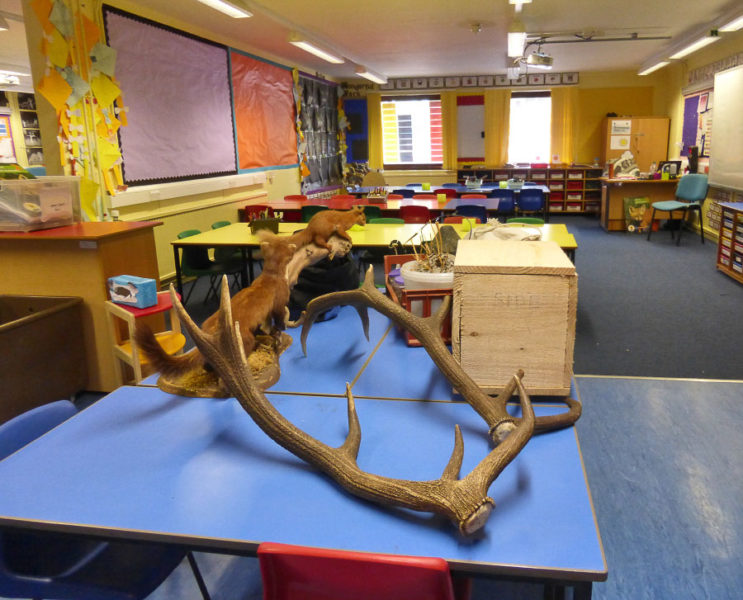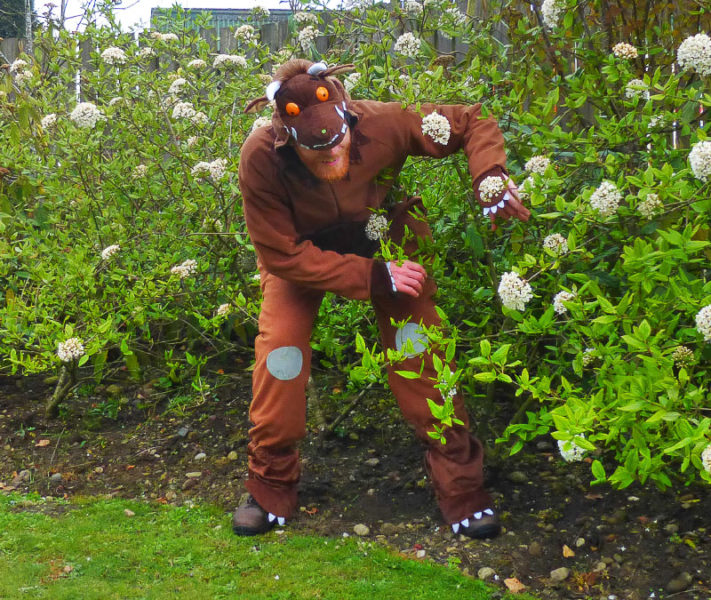
The onus is on parents and educators to try to ‘interpret’ the natural world for our kids, so that they can understand their place within it and recognise how vital its protection is. That can be as cheap and easy as making daisy chains, collecting conkers or blowing on dandelion clocks. Encourage young children to look at the small things around them and the rest will follow as their curiosity grows.

Antlers, hedgehog hibernation box and some old stuffed animals – props for a recent school visit with the Ranger Service. Getting ready to teach 30 six year olds about the animal kingdom.
Fitting nature into a modern world
I’ve never been what is described as an ‘early adopter’, one of those people eager for the next technological advance, excited at the way it could change my life, queuing up at midnight to buy the next iPhone. As a case in point, my phone is a brick from 2006. It texts, phones and…..well, that’s about it really. If someone sends me a photo from their smartphone I have to spend 20 minutes deleting texts to make space.
Frequently termed a ‘luddite’ by my friends, I always generally believed that the unprecedented leaps forward in pervasive technology we’re witnessing heralded the end of civilisation as we know it, because they are creating a generation in thrall to the digital, living virtual lives indoors, with no interest in the natural outdoors. But then I got a job as a countryside ranger.
Since doing so a few years ago I’ve worked with a lot of kids of primary school age, both in our Country Parks and on-site in local schools. We run all kinds of educational activities for them, and despite doing those same activities again and again, it still amazes me now, as much as it did the first time, just how much fun kids derive from the simplest of ‘offline’ things.
Only last month I was leading a group of eager pond dippers of mixed ages. We were catching the usual tadpoles, water boatmen, some midge larvae, and then all of a sudden I heard a cry….”I CATCHED A DRAGON, I CATCHED A DRAGON!!!”. One boy had netted a newt, and it was an event of such enormous magnitude that every single kid there excitedly downed tools to come and see. I felt bad explaining that it wasn’t a dragon, but it made the find no less exciting for them.
Another occasion springs to mind from my first year, when I was taking a group of 6 year olds to collect signs of autumn. I picked up a sycamore seed and prompted the semi-circle of kids to tell me what was special about it. None of them knew. They didn’t even recognise it. I picked up a handful of the seeds, threw them in the air, and watched the kids’ mouths drop open in amazement as the objects spun like helicopter blades, slowly falling to the ground. They were soooo excited! They all busily collected some to take home; their new, free, and practically inexhaustible toys, found lying on the ground in a West Lothian woodland. They were delighted and so was I.
I’ve been similarly encouraged to see how slightly older kids will happily play in a woodland for hours, playing Catch the Flag or building dens. I’m glad to say I’ve found my preconceptions about nature and technology being challenged.
At primary age kids don’t generally discriminate between what’s modern and what’s not, what’s cool and what’s not. They just react positively or negatively, without prejudice or preconception. That doesn’t last, however. Things change as they get older.
If ever you needed a sign that times are indeed changing you need only have attended the Conference for Nature in Edinburgh earlier this year, where conservation organisations, businesses and interested parties from across the country came together to take stock of the state of nature in Scotland.
As you might expect there was good news and bad news, but one of the most thought-provoking speakers for me, as a ranger, was Dr Alastair Lavery of the Field Studies Council, who spoke on the subject of the ‘disconnectedness’ from nature and the outdoors.
He told how the 2007 Oxford Dictionary for 7-9 yr olds had completely removed the words ‘acorn’ and ‘bluebell’ (among other nature nouns), and in their place were words like ‘analogue’ and ‘broadband’. 28 prominent authors apparently complained to the Oxford University Press (OUP), but the OUP’s response was that ‘acorn’ and ‘bluebell’ just aren’t used by kids any more. They said that kids’ language was changing.
That struck me as sad, but entirely reasonable given the OUP has limited space in its dictionary and those new words are undeniably important. But whether you agree or disagree with the omissions, it does indeed reveal how childhood experience is changing. Kids are increasingly tech-savvy and there’s no escaping the fact that tablets and other mobile devices already feature in their lives at a young age.
But arguably childhood experience always has been changing, and people have surely been making that nature vs technology argument for centuries. Growing up, the concern for my parents and others of their generation was that we kids of the computer age were spending too much time indoors. We should be out on our bikes, not sitting waiting for a Spectrum 48k game to load from a cassette recorder. Those were the days! And I turned out alright…..I think!

Something I never thought I’d find myself doing. Dressing up as the Gruffalo to teach kids about woodland creatures!
Now though, technology may indeed have become more pervasive and hard-wired into our daily lives, but it is mobile. It has been liberated from the four walls of our homes.
Smartphone apps have revolutionised the field of ‘citizen science’, whereby children can record and instantly submit their sightings to national surveys or migration maps. Whether it’s ladybirds, butterflies or garden birds. Apps also exist to help them identify wildlife in the field, and there are even ones to help them identify birdsong.
Others take the form of games that mimic natural ecosystems, where children can design their own landscapes and see what wildlife they attract or lose when they tinker with the design. And my personal favourites are the ones that allow you to scan the night sky and learn the names of the constellations.
It’s a brave new world indeed. As for me, well I’m moving forwards too, but I’d say I’m still more William Morris than Bill Gates, wearily watching the advance of the digital world and worrying about where it’s all headed.
Sure, you can be consumed by it if you allow yourself to be, but it needn’t be a case of “either/or”. The natural and the digital can combine together in innovative and educational ways, and mobile technology opens up enormous potential for the way in which children experience the natural world.
The natural drop off
That we lose some of that childlike wonder as we get older and our understanding becomes more sophisticated is perhaps inevitable. But it’s not a gradual process into old age, rather there’s a seriously big drop-off in engagement as children move into adolescence.
A graph shown at the Conference for Nature, one measuring the age of people against the percentage who think Scotland’s natural environment is important, starkly illustrated the point: at the young end of the scale engagement was very high, with a sudden drop off around the teenage years. Thereafter the graph line slowly recovered as people moved into their later years, but it never again matched the levels of enthusiasm shown by the younger kids.
With the best will in the world you’ll find it difficult to retain the same broad level of interest in adolescents. And I can’t say I blame them because that was pretty much my experience as one!

Checking the time on Overnight Survival Skills last year, as a dozen kids doze in their self-made shelter. Outdoor activities still appeal to kids of an older age.
I had a grounding in nature from an early age but it still got elbowed out of the way by other things: music, gigs, university and….erm….other things. Quite frankly, nothing on god’s green earth could have persuaded me to pick up a pair of binoculars and stare at birds on a bird table when I was a hungover 20 year old.
Years later, though, the interest in nature came back, albeit unexpectedly. I started hillwalking and, in so doing, came back into contact with the natural world. I found that nature hadn’t gone away. It was still there. And having had a grounding in it from an early age, when I did return to it, it was familiar and fairly easy to pick up where I’d left off.
But I’m not sure my experience is typical, to be honest. I don’t know how many people ever come back to it so soon and, as a countryside ranger, I admit I find that fact disheartening sometimes. The fact is that no matter what we do in our roles as educators and interpreters, we’ll probably ‘lose’ most of those kids within a few years because of events beyond our, or even their, control.
You can’t quite believe that the enthusiasm they have for the natural world can ever be diminished. But this phenomenon certainly isn’t confined to nature. How many of us started learning musical instruments when we were young only to give them up as we got older?
Of course, it’s only a general rule. Some will never lose that interest, even through adolescence. There are many budding young Chris Packhams out there, and that’s a huge cause for optimism. Take Jake McGowan-Lowe, the 13 year old ‘adolescent’ from Perthshire bucking the trend with a blog and book about wildlife and the bones he’s found. Young Jake is quite the celebrity, regularly appearing on TV and is surely one to watch in the future.
In all honesty though, I think the drop in engagement at adolescence is something we just have to live with. But if environmental education is sounding futile at this point, it really isn’t.
I do believe that a strong background in nature and the environment in early age gives you a secure grounding for later in life. Perhaps happy memories to draw upon when you get older, or when you have kids yourself. And through our ranger work there’s always the chance that we spark a longstanding interest of the natural world in some of the next generation. It’s always worth the effort!
One thing not to do
Whether you’re a parent or a teacher be really careful not to crush a child’s enthusiasm for the natural world. I’m reminded of my friend, who was running an autumn collection event. Kids went out and collected seeds, nuts, leaves etc. A little girl’s grandparents came to pick her up at the end of the day, at which point she excitedly presented them with her bag of pine cones and leaves. They were impressed, but said something along the lines of “that’s lovely, but mind you get rid of them before we get home. You know your mum won’t want them in the house”.
A few things to do
– Search the internet for ‘nature apps for kids’. Here’s a good place to start: http://www.brightpips.com/natures-child-apps-sites-help-kids-explore-natural-world/
– Some smartphones have remarkably good macro (close-up) options on their cameras. Encourage your kids to take close-ups of bugs, insects and leaves to reveal a whole new world! Stinging nettles are a good one as you can actually see the sting!
– Most Scottish ranger services have nature events for kids throughout the year. Find your nearest service at: http://www.scra-online.co.uk/the-ranger-profession/where-to-find-rangers
– Go back to basics and use natural items you find lying on the ground to make pictures (see photo below).


